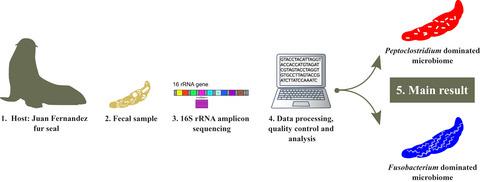当前位置:
X-MOL 学术
›
Microbiologyopen
›
论文详情
Our official English website, www.x-mol.net, welcomes your feedback! (Note: you will need to create a separate account there.)
Patterns of the fecal microbiota in the Juan Fernández fur seal (Arctocephalus philippii)
MicrobiologyOpen ( IF 3.4 ) Pub Date : 2021-07-23 , DOI: 10.1002/mbo3.1215 Constanza Toro-Valdivieso 1 , Frederick Toro 2, 3, 4, 5 , Samuel Stubbs 6 , Eduardo Castro-Nallar 7 , Barbara Blacklaws 1
MicrobiologyOpen ( IF 3.4 ) Pub Date : 2021-07-23 , DOI: 10.1002/mbo3.1215 Constanza Toro-Valdivieso 1 , Frederick Toro 2, 3, 4, 5 , Samuel Stubbs 6 , Eduardo Castro-Nallar 7 , Barbara Blacklaws 1
Affiliation

|
As apex predators, pinnipeds are considered to be useful bioindicators of marine and coastal environments. Endemic to a small archipelago in the South Pacific, the Juan Fernandez fur seal (JFFS) is one of the less-studied members of the pinniped family Otariidae. This study aimed to characterize the fecal microbiome of the JFFS for the first time, to establish a baseline for future studies of host–microbial–environment interactions and monitoring programs. During two consecutive reproductive seasons, 57 fecal samples were collected from seven different JFFS colonies within the Juan Fernandez Archipelago, Chile. Bacterial composition and abundance were characterized by sequencing the V4 region of the 16S rRNA gene. The overall microbiome composition was dominated by five phyla: Firmicutes (40% ±24), Fusobacteria (30% ±17), Bacteroidetes (22% ±10), Proteobacteria (6% ±4), and Actinobacteria (2% ±3). Alpha diversity was higher in Tierras Blancas. However, location was not found to be a dominant driver of microbial composition. Interestingly, the strongest signal in the data was a negative association between the genera Peptoclostridium and Fusobacterium, which explained 29.7% of the total microbial composition variability between samples. The genus Peptoclostridium has not been reported in other pinniped studies, and its role here is unclear, with interpretation challenging due to a lack of information regarding microbiome functionality in marine mammals. As a first insight into the JFFS fecal microbiome, these results contribute towards our understanding of the natural microbial diversity and composition in free-ranging pinnipeds.
中文翻译:

Juan Fernández 毛皮海豹 (Arctocephalus philippii) 粪便微生物群的模式
作为顶级捕食者,鳍足类动物被认为是海洋和沿海环境的有用生物指标。胡安费尔南德斯海狗 (JFFS) 是南太平洋一个小群岛的特有种,是鳍足类海狗科中研究较少的成员之一。本研究旨在首次表征 JFFS 的粪便微生物组,为未来宿主-微生物-环境相互作用和监测程序的研究建立基线。在连续两个繁殖季节期间,从智利胡安费尔南德斯群岛的七个不同 JFFS 殖民地收集了 57 份粪便样本。通过对 16S rRNA 基因的 V4 区域进行测序来表征细菌组成和丰度。整体微生物组组成由五个门类主导:厚壁菌门(40% ±24)、梭杆菌(30% ±17)、拟杆菌(22% ±10)、变形菌(6% ±4) 和放线菌(2% ±3)。Tierras Blancas 的 Alpha 多样性更高。然而,并未发现位置是微生物组成的主要驱动因素。有趣的是,数据中最强的信号是Peptoclostridium和Fusobacterium属之间的负相关,这解释了样本之间总微生物组成变异的 29.7%。消化梭菌属尚未在其他鳍足类研究中报道,其在此处的作用尚不清楚,由于缺乏有关海洋哺乳动物微生物组功能的信息,解释具有挑战性。作为对 JFFS 粪便微生物组的首次了解,这些结果有助于我们了解自由放养的鳍足类动物的天然微生物多样性和组成。
更新日期:2021-07-24
中文翻译:

Juan Fernández 毛皮海豹 (Arctocephalus philippii) 粪便微生物群的模式
作为顶级捕食者,鳍足类动物被认为是海洋和沿海环境的有用生物指标。胡安费尔南德斯海狗 (JFFS) 是南太平洋一个小群岛的特有种,是鳍足类海狗科中研究较少的成员之一。本研究旨在首次表征 JFFS 的粪便微生物组,为未来宿主-微生物-环境相互作用和监测程序的研究建立基线。在连续两个繁殖季节期间,从智利胡安费尔南德斯群岛的七个不同 JFFS 殖民地收集了 57 份粪便样本。通过对 16S rRNA 基因的 V4 区域进行测序来表征细菌组成和丰度。整体微生物组组成由五个门类主导:厚壁菌门(40% ±24)、梭杆菌(30% ±17)、拟杆菌(22% ±10)、变形菌(6% ±4) 和放线菌(2% ±3)。Tierras Blancas 的 Alpha 多样性更高。然而,并未发现位置是微生物组成的主要驱动因素。有趣的是,数据中最强的信号是Peptoclostridium和Fusobacterium属之间的负相关,这解释了样本之间总微生物组成变异的 29.7%。消化梭菌属尚未在其他鳍足类研究中报道,其在此处的作用尚不清楚,由于缺乏有关海洋哺乳动物微生物组功能的信息,解释具有挑战性。作为对 JFFS 粪便微生物组的首次了解,这些结果有助于我们了解自由放养的鳍足类动物的天然微生物多样性和组成。



























 京公网安备 11010802027423号
京公网安备 11010802027423号